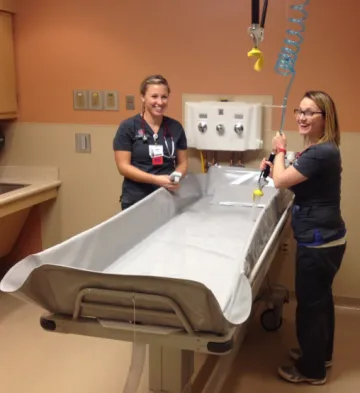UAMC's New Burn Treatment Room Grand Opening

The University of Arizona Medical Center University Campus is opening a new Burn Treatment Room on Monday, Dec. 15, 10-11:30 a.m. Former patients, Tucson Mayor Jonathan Rothschild and executives from the hospital and Tucson Fire Foundation will talk about how this new addition advances burn care in our community at a special opening presentation to be held at the Arizona Cancer Center Kiewit Auditorium, UAMC University Campus, 1501 N. Campbell Ave.
This new treatment room provides new capacity to treat burn patients throughout Southern Arizona, which has not had an inpatient burn program since 2008. With enhanced capabilities, UAMC can now treat seriously injured patients so they may remain in Tucson for trauma burn care and follow-up treatment.
The Burn Program at UAMC University Campus features a state-of-the-art hydrotherapy room. Hydrotherapy (shower) treatment washes away dead skin and bacteria, minimizing a patient's risk of infection. Hydrotherapy uses warm running water to help the healing process of a burn injury.
The Burn Treatment Room was made possible from proceeds totaling $70,000 from the University of Arizona Division of Trauma M*A*S*H Bash fundraising event in 2012, and an additional $10,000 donation from the National Fallen Firefighters Foundation.
The room is equipped with:
- Shower trolley which enables a seriously injured patient, who is not able to sit or stand in a traditional hospital shower space, to lie down to be cleansed or wounds debrided. This trolley may go to bedside and transport patient to the treatment room.
- Water controls to give nursing or medical staff the ability to control temperature and pressure. Water control also disinfects the water system in the room along with the trolley.
- Ceiling-mounted radiant heater to help a critical injured patient keep a stable body temperature. Patients with large body surface tissue injuries have a difficult time staying warm due to their burns and inability to thermoregulate.
- Water resistant walls and floor including floor sink to ensure the room is able to contain the amount of water that is used and spilled during an extensive treatment.
- Cabinet space to store specialized medical supplies, including medications and dressings required to care for this complex patient. This will allow for a rapid treatment and lessen the discomfort of the treatment.
- Computer in the room to access patient charts and update treatment plans.

